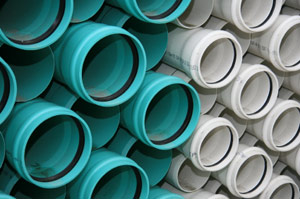Sewage Lift Station
Effective Alternatives to Septic Systems Sewage lift stations are designed to move wastewater from a lower elevation up to a higher one, so that it can be transported through municipal sewer lines for eventual processing and cleaning at a treatment plant. A key benefit of such a station is that it facilitates the building of homes or commercial buildings at ground levels below the elevation of a city's sewer main, without necessitating use of a septic system.
Lift stations operate in a relatively simple manner. A water level monitoring mechanism sends a signal to the station's control panel to indicate that the liquid sewage level has risen to the trigger point for pump operation. Once the liquid has been evacuated to the shutoff trigger level and discharged to the main sewer line, the system resets and waits for chamber to fill again. An internal valve is part of the system, and it keeps any wastewater remaining in the connector pipe from being dumped back into the reservoir.
Sewage lift stations are fitted with pumps made specifically for transporting effluent. It is critical that these pumps are of durable construction and are particularly resistant to corrosion. Their motors and electrical connections must be sealed against water invasion. As sewage collection reservoirs are marked by high levels of acidity, these pumps are necessarily fabricated to withstand the stress and corrosive potential. Designed to be submerged in water, the pump bodies are frequently rendered in cast bronze, iron and plastic composites. Hardware on sewage lift pumps is generally made in stainless steel. By virtue of their location and necessary surroundings, sewage lift stations operate under very inhospitable ambient conditions. Because they are, by definition, installed in relatively inaccessible, invisible locations, they often are not maintained as well as they otherwise might be.
While installation of a sewage lift station can be a very useful decision, stations are not without potential problems and malfunctions. A common issue related to sewage lift station operation is that of odor accumulation. Sewer gas that has collected in the confined space of the lift station poses risks of toxicity, underground explosions and damage to sewer lines. Methods for alleviating the dangers include aeration and the introduction of chemical additives such as sodium nitrate to elevate oxygen levels in the reservoir. Scented products can also be used to ameliorate the more practical nuisance to neighbors caused be excess sewer gas.
Another issue that can interfere with the operation of sewage lift stations is that of oil and grease accumulation. Fats and oils can cause blockages in sewage collection mechanisms and ultimately cause water treatment difficulties. When wastewater systems become blocked, sewage spills can occur and backups in residential dwellings and business structures can cause significant damage.
Grease and oil is not soluble in the water collected in the sewage collection reservoir, separates from the fluid, and can limit the ability of the lift pump system to function effectively. When these substances accumulate in substantial amounts, sewer lift systems will require more frequent cleaning, and perhaps even expedited replacement. When oil and grease make it through to the city sewer main and travel onward to the water treatment plant, they can cause additional problems there, some of which can be serious enough to temporarily shut down wastewater cleaning operations. Possible solutions for oil buildup in lift station operations include the addition of biological agents that help eliminate grease accumulations, cut down on emitted odors, and keep transmission lines clear.

While the basic concept of how a sewage lift station and sewage lift pump works is a relatively simple one, their installation, maintenance and repair can be complicated. Simply by virtue of their location, these systems can pose problems and challenges that can be cumbersome for a novice to tackle. When considering installation of a lift system as part of a new construction project, or perhaps as part of an addition to an existing structure, it may be useful to consult with an engineer able to design the station and create plans for its installation. Utilizing professional expertise is likely to facilitate a smoother municipal inspection and approval process than would otherwise be possible.
When it comes time to install the sewer lift station itself, project managers and homeowners alike are well advised to enlist the help of licensed plumbers and sewer contractors. Maintenance and repair issues are likely to develop at one point or another during the station's useful life, and such work is best delegated to professionals experienced in servicing systems of all types. By gaining an understanding of the concepts and principles underlying the operation of sewer lift stations, and making the conscious decision to hire licensed professionals to install, repair and maintain these systems, one can truly appreciate the benefits they can confer in removing the need for high maintenance septic tanks.
More Home Service Solutions
Installing a new dishwasher? Learn how to install a dishwasher.
Installing a new toilet? Learn how to install a toilet.
If you own rental property, chances are you will need legal documentation to protect yourself. While interest rates may be low now, many people are still unable to get those great rates due to the difficult standards now needed. High credit scores and big down payments just for starters. Some investors are opting to help prospective homeowners by offering financing or a lease option on rental property. Whatever your investment strategy, make sure you are protected with a residential lease agreement, drafted by a real estate attorney knowledgeable of the lease and real estate laws in your state.